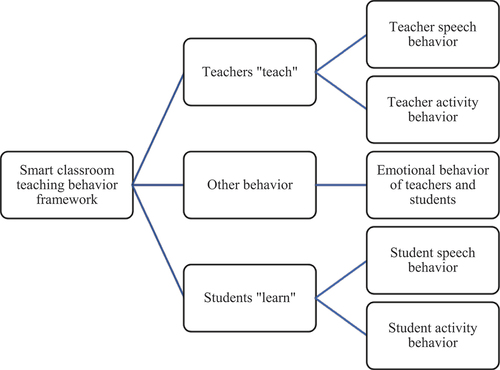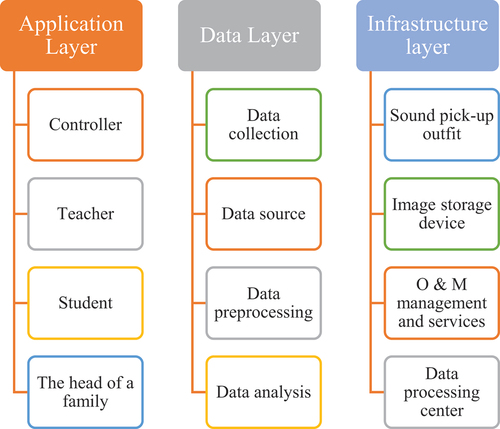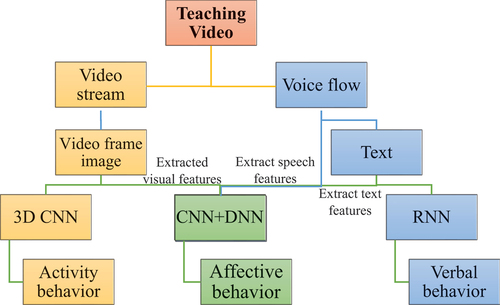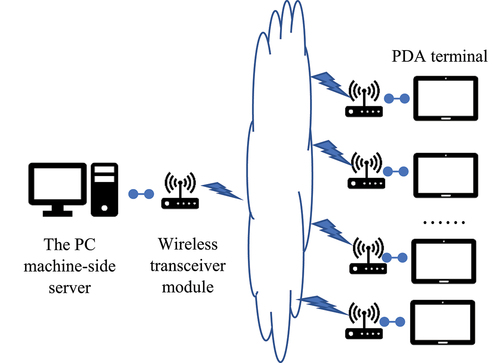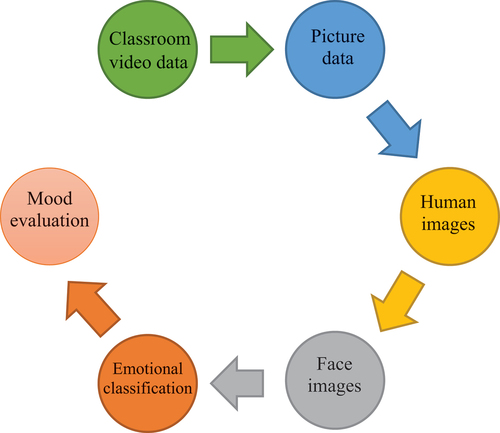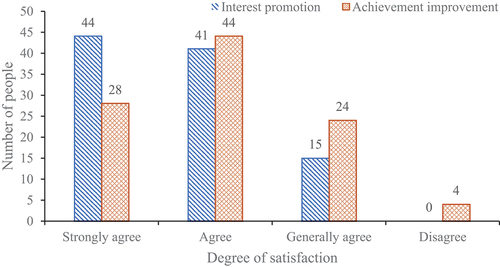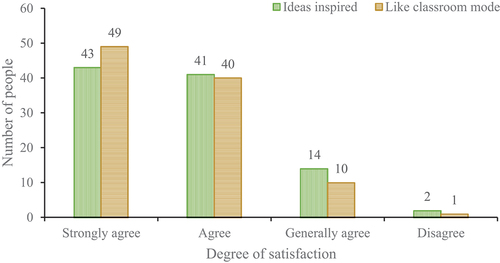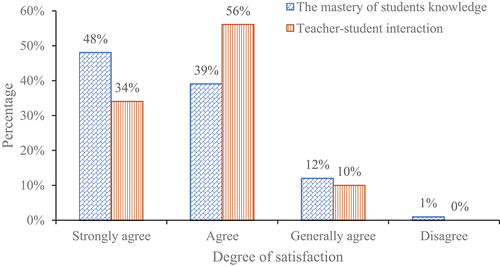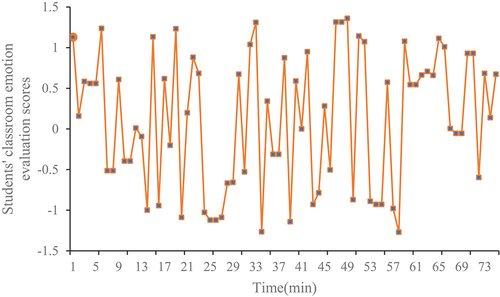 ?Mathematical formulae have been encoded as MathML and are displayed in this HTML version using MathJax in order to improve their display. Uncheck the box to turn MathJax off. This feature requires Javascript. Click on a formula to zoom.
?Mathematical formulae have been encoded as MathML and are displayed in this HTML version using MathJax in order to improve their display. Uncheck the box to turn MathJax off. This feature requires Javascript. Click on a formula to zoom.ABSTRACT
With the continuous evolution and advancements in artificial intelligence (AI), network technologies have witnessed substantial improvements. Against the backdrop of the Corona Virus Disease 2019 pandemic, wireless classrooms have emerged as a significant modality for education. This study delves into the integration mechanisms and methodologies of AI-based wireless classrooms across diverse educational institutions. Building upon previous accomplishments, this work elucidates the fundamental aspects of AI, explicates the underpinnings of wireless classrooms, and analyzes pertinent components. Additionally, the study summarizes the elements of audience engagement in the context of wireless networks. The effectiveness of wireless classrooms is assessed through a questionnaire survey administered to students, exploring their perceptions and experiences in independent learning. Furthermore, by incorporating relevant classroom knowledge and employing a well-structured management mechanism, wireless classrooms exhibit distinct advantages over traditional classroom setups, fostering visual feedback, bolstering students’ independent learning capabilities, and elevating the overall quality of modern teaching.
Introduction
In the process of students’ learning, classroom teaching is the most important link for students to acquire knowledge. In the classroom, how to do well the interaction between students and teachers is the key to improving the teaching quality (Bai and Zhang Citation2020). In the existing mode, there is room for improvement in all aspects. In the process of signing before class, roll-call or paper-delivered signatures are currently used, which are inefficient and have allographs. In the interactive session, when students raise their hands to answer, it is difficult to count and record the answers on time (Revathi, Suganya, and M Citation2020). It shows that the traditional classroom teaching mode cannot meet the needs of modern teaching. It is necessary to develop new attendance management, intelligent classroom, video surveillance, and other intelligent classroom teaching modes to ensure students’ autonomous learning ability through visual behavior feedback.
With the continuous development of artificial intelligence (AI), traditional classroom teaching has also experienced the convenience brought by it. As one of the most advanced technologies in the world, AI has brought new opportunities and challenges to the teaching of various courses in colleges (Sun and Li Citation2020). The new generation of intelligent education will take AI as the core, provide self-adaptive teaching methods, and analysis tools for teaching and learning, and bring a fundamental change to the traditional education model and a qualitative leap in teaching effect (Liu et al. Citation2021). It has strong epochal, comprehensive, practical, creative and instrumental characteristics, injecting fresh blood into the innovation of smart classroom teaching. It can be predicted that intelligent technology will lead to a change in teaching classrooms and a new era of education is coming (Yu and Bhardwaj Citation2022).
The foundation of smart classrooms is the Internet of Things technology, which requires wireless network coverage. The wireless switch is used to build a wireless local area network (LAN), the wireless network covers the whole smart classroom. Meanwhile, various sensors for different purposes realize the connection between serial communication and wireless network through the wifi device server to complete the information transmission and build a smart classroom with complete functions (Zhang, Li, and Zhu Citation2019). Smart classrooms need to have electronic whiteboard functions. Meanwhile, technologies such as wireless networks and sensors are introduced to make classroom teaching more abundant and vivid. The interaction between teachers and students is more convenient, and the way students obtain teaching resources is diversified. A new classroom with situational awareness and environmental management functions is formed (K and N 2019).
Firstly, based on the analysis of classroom teaching behavior of AI, this work analyzes classroom teaching behavior by using the smart classroom teaching framework model, expands the evaluation dimension, and improves the evaluation efficiency to achieve real-time feedback and real-time attention to the classroom effect. Secondly, a questionnaire survey of teachers and students in a school is carried out to study the effect of the introduction of AI into classroom teaching and the places that need to be improved, effectively regulate classroom teaching behavior, and promote the cultivation of teachers’ professional ability. Finally, this work studies the use of wireless network sensor mechanisms in classroom teaching scientifically and accurately improves the correction of teaching problems and the quality of education and teaching, and promotes the individualized and standardized growth of students.
The aim of this research is to examine the integration of artificial intelligence (AI) in contemporary smart classrooms. By conducting a questionnaire survey among colleges regarding the implementation of smart classrooms, this study identifies teaching challenges and proficiency objectives related to online courses. A solution that facilitates a multi-dimensional teaching approach in the online classroom is proposed. Furthermore, an investigation into the sensor mechanism of wireless network coatings is conducted to ensure the efficacy of wireless classrooms. Real-time monitoring of asset operations within smart classrooms is carried out to guarantee the smooth functioning of the wireless network during teaching activities. Additionally, an analysis of classroom monitoring systems employing AI is undertaken to discern students’ visual behaviors, thereby providing insights into their self-directed learning status. The amalgamation of visual management and data analysis forms a cohesive framework, serving as a foundation for fostering personalized student growth.
The motivation behind this work stems from the growing importance of integrating artificial intelligence (AI) into educational environments, specifically within smart classrooms. With the rapid advancements in technology, it is crucial to explore the potential benefits and challenges associated with the introduction of AI in the educational sector. By investigating the current state of smart classrooms and conducting a thorough analysis of teaching difficulties and goals in online courses, this study aims to address the need for a more comprehensive and effective teaching approach. Additionally, by examining the sensor mechanism of wireless network coatings and implementing real-time monitoring of classroom assets, the researchers seek to ensure the smooth operation of the wireless network, which is essential for seamless classroom activities. Moreover, by studying the application of AI in classroom monitoring systems, the aim is to gain insights into students’ visual behaviors and utilize this information to enhance personalized learning experiences.
Also, this work makes several significant contributions to the field of education and technology integration within the classroom:
Identification of Teaching Challenges and Goals: Through the questionnaire survey conducted among colleges, this research identifies key teaching difficulties and proficiency objectives related to online courses in smart classrooms. The findings contribute to a deeper understanding of the obstacles faced by educators in this context and provide valuable insights for developing effective teaching strategies.
Development of a Multi-Dimensional Teaching Solution: By addressing the identified challenges, this study proposes a solution that facilitates a multi-dimensional teaching mode in the online classroom. The developed approach aims to enhance the quality and effectiveness of teaching, providing educators with a framework to deliver engaging and impactful online courses.
Enhancement of Wireless Classroom Infrastructure: By investigating the sensor mechanism of wireless network coatings, this work ensures the application effectiveness of wireless classrooms. The real-time monitoring of asset operations within smart classrooms helps maintain the normal functioning of the wireless network during teaching activities, contributing to a seamless and uninterrupted learning experience.
Integration of AI in Classroom Monitoring Systems: Through the study of classroom monitoring systems employing AI, the research summarizes students’ visual behaviors and provides feedback on their autonomous learning status. The integration of visual management and data analysis forms a cohesive framework that offers educators valuable insights into students’ learning progress, thereby promoting personalized growth.
In summary, this research provides valuable contributions to the understanding and implementation of AI in smart classrooms, offering solutions to teaching challenges, enhancing the wireless classroom infrastructure, and utilizing AI for improved classroom monitoring and personalized learning experiences.
Literature Review
In 1956, at the Dartmouth Conference organized by several AI pioneers such as Marvin Minsky, the concept and discipline of “AI” was first proposed (Zhang and Lu Citation2021). With the passage of time and the progress of technology, the concept of AI is also expanding. The understanding of AI is different. Chen believes that AI not only replicates and imitates human intelligence but also contains various computational capabilities beyond human beings (Chen, Chen, and Lin Citation2020). The more common definition at present believes that AI has three elements: data, computing power, and algorithm. It is a theory, method, technology, and application system that studies human intelligence and simulates, extends, and expands technical science (Vaishya et al. Citation2020).
Bature et al. have published 111 papers on the theme of teaching effectiveness. By reviewing 12 important papers, classroom teaching from the aspects of key factors analysis, cultural influence, participants, and teacher guidance are analyzed, and some methods and suggestions are put forward for improving the teacher effectiveness (Bature I and Atweh Citation2019). From the wide spread of popular modern educational technology, Fitchett found that flipped classrooms, E-Learning, etc. lack effective feedback mechanisms from teachers to students, resulting in low teaching efficiency. Therefore, he proposed micro-adaptive teaching methods and tools to assist these technologies to promote the development of education and teaching (Fitchett and Heafner Citation2018). Cohen and his team predicted effective curriculum transmission strategies by designing mathematical models and tools and other data mining technologies, which were used for regression analysis and fitting tests of students’ behaviors. They used emerging technologies to diagnose and predict classroom teaching behaviors, combined with student’s classroom performance, and adjusted reasonable teaching activities to improve classroom teaching effect, laying the foundation for improving the classroom teaching quality (Cohen et al. Citation2020).
Chassignol et al. proposed that educational AI was a new field integrating AI and educational science. It mainly creates conditions for students’ learning by understanding and analyzing the learning process (Chassignol, Khoroshavin, and Klimova Citation2018). Guan et al. put forward that educational AI was to put intelligent teaching platforms into use so that students could learn more actively. They also emphasized that intelligent technology could be combined with the field of the robot. Botty, an intelligent assistant, was developed through MOOC learning and applied to practical teaching. It is found that Botty can improve the classroom teaching effect and promote the relationship between teachers and students (Mou, Jiang, and Jiang Citation2020). Ikedinachi et al. proposed strategies to optimize learners’ learning process after further exploring what aspects of AI technology will change learners’ learning process (Ikedinachi A et al. Citation2019).
This study represents a comprehensive exploration of the integration of AI in education, particularly focusing on its introduction into the classroom environment. The researchers have conducted extensive research and engaged in in-depth discussions regarding the application of AI technology in educational settings. By examining the evolutionary process of combining AI and education, it becomes evident that there is a growing emphasis on creating intelligent and diverse teaching classrooms, with the aim of leveraging intelligent technology to support students’ specific learning needs. Building upon the application of AI in the classroom, this work delves into the mechanism of wireless network integration within the classroom teaching system. It emphasizes that the equipment utilized must meet functional requirements while maintaining stable and reliable performance to ensure the overall quality of classroom teaching.
This work aims to address a significant research gap in the field of AI integration in education, specifically in the context of smart classrooms. While previous research has explored the application of AI in educational settings, there is a lack of comprehensive studies that specifically focus on the introduction of AI technology in smart classrooms and its impact on teaching and learning processes.
The existing literature has mainly touched upon general aspects of AI in education, such as its potential benefits and challenges, without delving into the specific implementation and mechanisms required for successful integration within smart classrooms. This research seeks to bridge this gap by providing a thorough examination of the practical aspects and intricacies involved in deploying AI technology in the classroom setting.
Furthermore, this work also addresses a research gap in terms of wireless network implementation within smart classrooms. While wireless networks are commonly utilized in educational institutions, limited research has been conducted on their integration into the classroom teaching system and the specific requirements and considerations for ensuring stable and reliable performance. This study fills this research gap by exploring the mechanism of wireless network deployment and its impact on the quality of classroom teaching.
By focusing on these specific aspects of AI integration in smart classrooms and the wireless network infrastructure, this research contributes to a deeper understanding of the practical challenges and opportunities associated with AI implementation in educational settings, thus providing valuable insights for researchers, educators, and policymakers seeking to enhance the effectiveness and efficiency of teaching and learning in the digital age.
Method
Smart Classroom Teaching Behavior Framework Model
This work aims to use AI technology for holographic analysis of classroom activities and comprehensive observation of classroom teaching from multiple dimensions and perspectives. Combined with five classical classroom teaching behavior analysis methods and classroom teaching evaluation requirements under the guidance of an efficient classroom, the analytical framework of classroom teaching behavior based on AI technology will be constructed through the following indicator dimensions (Bin et al. Citation2019). The specific hierarchical model is shown in :
In order to verify the feasibility and effectiveness of the classroom teaching behavior framework based on artificial intelligence technology, the emerging artificial intelligence technology is used to open the black box of the classroom teaching process, to realize the collection, marking, and analysis of behavior, and to visualize teachers and teachers in the classroom. The real behavior of students reduces the workload of subsequent manual analysis, realizes technology-driven analysis and teaching, and better improves the quality of education and teaching. Combined with the analysis of technology-driven classroom teaching behavior, this work proposes an analysis system for classroom teaching behavior based on AI technology. The system structure is divided into three layers: infrastructure layer, data layer, and application layer (Hwang G et al. Citation2020). The specific analysis system structure is shown in .
Apply the smart classroom teaching analysis framework and system to real classroom scenarios, and collect, mark, analyze and process classroom teaching behavior data (Chen et al. Citation2020). After building a classroom teaching behavior analysis system based on AI technology on the analysis framework, the analysis process based on AI technology in the real classroom scene is sorted out, and the classroom teaching behavior with AI technology is analyzed. The flow chart of classroom teaching behavior is shown in .
With the above analysis framework model of classroom teaching behavior based on AI technology, the operability of the smart classroom is clearer. The analysis framework is applied to the real classroom, and the performance of teachers and students in the smart classroom is sorted out. Through questionnaires and interviews, teachers’ satisfaction with the teaching mode and the influence of personal professional development are investigated from the two perspectives of teachers’ teaching and students’ learning Meanwhile, students’ learning situation and their views on the smart classroom, learning effect, and satisfaction are investigated.
The above analysis framework model of classroom teaching behavior based on AI technology provides a structured approach to examining and understanding the operability of smart classrooms. By implementing this analysis framework in a real classroom setting, researchers can gain valuable insights into the performance of both teachers and students within the smart classroom environment.
To evaluate the effectiveness of the analysis framework, questionnaires and interviews can be conducted to collect data from multiple perspectives. Firstly, the satisfaction of teachers with the teaching mode can be assessed, along with an investigation into the influence of the smart classroom on their personal professional development. This can involve obtaining feedback from teachers regarding their experiences, challenges, and perceived benefits of utilizing AI technology in their teaching practices. By gathering this information, the researchers can gain a comprehensive understanding of the impact of the smart classroom on teachers and their professional growth.
Secondly, the analysis framework allows for an evaluation of students’ learning situations and their perceptions of the smart classroom, learning effectiveness, and overall satisfaction. Through questionnaires and interviews, researchers can gather data on students’ experiences, engagement levels, and perceptions of the smart classroom environment. This includes assessing their views on the integration of AI technology, their learning outcomes, and their overall satisfaction with the learning process. This data will provide insights into the effectiveness of the smart classroom in facilitating student learning and engagement.
By combining the perspectives of both teachers and students, the analysis framework offers a holistic view of the smart classroom’s impact on teaching and learning processes. It enables researchers to identify strengths, weaknesses, and areas for improvement in the implementation of AI technology within the classroom environment.
Moreover, the technical aspects of the analysis framework should be reviewed to ensure its validity and reliability. This includes examining the methodology used to collect data, such as the design and administration of questionnaires and the structure of the interview process. Additionally, the data analysis techniques employed should be reviewed to ensure they are appropriate for addressing the research questions and providing meaningful insights. This may involve employing statistical methods to analyze quantitative data and utilizing qualitative analysis techniques to examine interview responses.
Overall, by applying the analysis framework to real classrooms and investigating teachers’ and students’ perspectives, this work contributes to a deeper understanding of the effectiveness and impact of AI technology in the smart classroom. It provides a comprehensive evaluation of the teaching and learning experiences within the smart classroom environment and offers valuable insights for improving future implementations and optimizing the benefits of AI technology in education.
Questionnaire Survey
This questionnaire study is conducted based on the basic situation of the construction of a school’s smart classroom, and 100 students and 10 teachers are selected for investigation, and the number of males and females is divided half. The questionnaires are produced and distributed through the Questionnaire Star platform. The basic information on the teaching age and educational background of the teachers who participated in the filling is shown in .
Table 1. Basic information about teachers.
A total of 13 questions are designed for the questionnaire implemented by students, and the survey content is divided into six categories: first, the survey of students’ basic situation; second, students’ views on intelligent classrooms based on AI technology; third, students’ views on teachers’ teaching methods; fourth, the application of AI technology in the classroom; fifth, the problems encountered in smart classroom learning; sixth, students’ suggestions on the future development of the integration of thinking and technology. The specific questionnaire contents are shown in .
Table 2. Contents of the Student Questionnaire.
The content of the questionnaire designed for the teachers participating in this work is divided into four categories: the basic situation of teachers, teachers’ views on AI technology, teachers’ views on teaching models, and teachers’ views on AI technology to promote teachers’ professional development. The specific content of the questionnaire is presented in .
Table 3. Contents of Teacher Questionnaire.
The data collected in this questionnaire is analyzed by linear regression with the help of SPSS software, which can greatly improve the efficiency of the data regression analysis process. The hypothesis test of the regression model is to find out reasonable parameters under certain probability and to test whether the representativeness of the sample is obvious and the influence relationship is obvious. It mainly includes two aspects: on the one hand, test the fitting degree of the regression equation to sample data; on the other hand, test the aboriginality of the regression equation, and assume the test judgment, to determine whether the linear relationship between the explained variable and the explanatory variable in the model is aboriginal or not. It includes the test of the linear regression equation and the test of the regression coefficient.
In the univariate regression model, parameter R2 is introduced to determine the fitting degree of sample observation; in the multivariate model, it can get the coefficient R2:
In EquationEquation (1)(1)
(1) , the value range of R2 is (0,1), and the closer to 1, indicating that the model fits better. RSS represents the sum of squares of regression, TSS represents the sum of squares of total deviation, and ESS represents the sum of squares of residuals. They have the following relationship:
represents the actual value,
represents the fitting value,
represents the average value of the actual value, so R2 can be expressed as:
R2 is used to test the statistical significance and hypothesis testing of multiple regression equations. The test statistic is F, which is expressed as:
In EquationEquation (7)(7)
(7) , p denotes the number of independent variables and n denotes the number of observed objects.
The equation aboriginality test is usually carried out by variance analysis method, that is, F test to test the aboriginality of the whole regression model, and then test its coefficient one by one.
The equation aboriginality test, also known as the specification test or overall significance test, is a statistical method commonly used to assess the validity and significance of a regression model as a whole. It aims to determine if the independent variables collectively have a significant impact on the dependent variable.
One of the widely employed techniques to conduct the equation aboriginality test is variance analysis, specifically using the F-test. The F-test evaluates whether the variation in the dependent variable explained by the regression model is significantly different from the variation that is not explained by the model. This test provides an overall assessment of the statistical significance of the regression model.
The F-test involves comparing the explained variance, known as the sum of squares due to regression (SSR), with the unexplained variance, known as the sum of squares due to error (SSE). The F-statistic is calculated by dividing the ratio of SSR to the degrees of freedom associated with SSR by the ratio of SSE to the degrees of freedom associated with SSE. The resulting F-statistic follows an F-distribution.
If the calculated F-statistic exceeds the critical value of the F-distribution at a predetermined significance level, it indicates that the regression model as a whole is statistically significant. This implies that at least one of the independent variables has a significant impact on the dependent variable.
However, it is important to note that while the equation aboriginality test provides an overall assessment of the regression model’s significance, it does not reveal which specific independent variables are significant. To identify the individual significance of the coefficients, further tests are required.
Typically, after establishing the overall significance of the regression model, subsequent tests are conducted to evaluate the significance of each coefficient. These tests, often performed using t-tests, assess whether each coefficient is significantly different from zero. By examining the significance of individual coefficients, researchers can determine the specific variables that have a significant impact on the dependent variable.
In summary, the equation aboriginality test, commonly conducted using the variance analysis method and the F-test, evaluates the overall significance of a regression model. It assesses whether the collective influence of the independent variables is statistically significant. Subsequent tests on the individual coefficients are necessary to identify which specific variables have a significant impact on the dependent variable.
Wireless Sensor Mechanism
Wireless network classroom teaching based on AI to truly achieve a classroom teaching network, it is necessary to ensure the stability of the wireless communication terminal system. The PDA (Personal Digital Assistant) terminal of the wireless classroom teaching network is studied. The device selection and circuit design of each module of the system are carried out, and the structural diagram of the system is given (Shan, Talha, and Khalaf Citation2021). Two AT89C52 microcontrollers are used as the central processor of the master-slave CPU (Central Processing Unit). The wireless communication module is connected through the serial port to give full play to the hardware performance and enhance the flexibility and stability of the system to ensure the smooth progress of the teaching class (Yang et al. Citation2022). It can support a small wireless teaching network in the classroom, and can form a class of personal PDA networks to organize teaching, as shown in .
The software of the system is an important part of realizing the function of the system and improving the overall performance of the system. Good system software can give full play to the hardware performance of the system and enhance the flexibility and stability of the system (Lu et al. Citation2022). The general system software is divided into the single-task system and multi-task system. The tasks of a single-task system are serially executed, while the multi-task system is the concurrent execution of parallel multi-task on the macro level, which usually depends on a multi-task operating system (Hyndman Citation2018). Considering the software complexity of the system, the software architecture of the system is based on the embedded real-time operating system UCOS-II platform. System software design is divided into four levels hardware driver layer UCOS-II operating system layer, function module layer, and application software layer. The system software architecture is displayed as .
The operating system used in this experiment is Windows10, the programming language is Python3.6, the experimental hardware parameters are i9 – 7920× CPU and 32GDDR4 memory, and the display card is NVIDIAGTX1080TillG. The deep learning framework used is Tensorflow. All data processing and experimental development tests are carried out on this platform (Peng, Wang, and Venkateswaran Citation2022).
Based on the construction of the wireless network system, this work analyzes the example classroom teaching video through speech recognition and image recognition, and obtains the emotional tendency score by intelligent analysis algorithm in AI technology. Additionally, this work presents the visual graph of students’ emotional change in the classroom, and obtains the overall emotional analysis and evaluation of students in the classroom. Videos including student perspectives and classroom panoramic perspectives are collected combined with the experimental purpose, the observation dimension and evaluation dimension of the analysis framework. In the experiment, combined with different analysis indexes, the collected classroom teaching video is processed, and the image data and voice data are processed by intelligent technology. The emotional analysis of the students is carried out. shows the overall analysis steps.
Based on the construction of the wireless network system, this work provides a detailed and technical analysis of the integration of AI technologies in the classroom. Specifically, the researchers employ speech recognition and image recognition techniques to analyze a sample classroom teaching video. By leveraging intelligent analysis algorithms in AI technology, the study aims to obtain an emotional tendency score for the individuals in the video.
The research then proceeds to present a visual graph that depicts the emotional changes of the students within the classroom. This visualization allows for a comprehensive understanding of the emotional dynamics in the learning environment. Furthermore, the study conducts an overall emotional analysis and evaluation of the students based on the collected video data. The researchers collect videos from various perspectives, including student perspectives and classroom panoramic perspectives, to ensure a comprehensive analysis framework that considers different observation dimensions and evaluation criteria.
To carry out the experiment, the collected classroom teaching videos are processed using intelligent technology, taking into account different analysis indexes. Both image data and voice data are subjected to intelligent processing techniques to extract emotional insights from the students. in the research paper illustrates the overall steps involved in the analysis process.
This detailed technical approach showcases the integration of AI technologies in analyzing classroom environments and student emotions. By combining speech recognition, image recognition, and intelligent analysis algorithms, the study provides a comprehensive and data-driven understanding of students’ emotional states during the teaching and learning process. This analysis framework not only captures the emotional dynamics but also facilitates the evaluation and monitoring of students’ emotional well-being in the classroom.
In the process of facial emotion recognition, the facial emotion at each time can be divided into three categories: positive, negative, and neutral, and the corresponding scores are given, and the scores are between 0 and 1. In order to facilitate the subsequent quantitative analysis, the positive value is set to be positive, ranging from 0.5 to 1.5, that is, the scores of neural network output are positive. The negative value is set to be negative, and the scores range from −1.5 to −0.5, that is, the scores of neural network output are negative, while the neutral value is set to −0.5 to 0.5, and the scores obtained are 0.5 minus the scores of neural network output. For image input at different times, different emotional evaluation scores are obtained at each time.
In the process of facial emotion recognition, the analysis of facial expressions aims to categorize emotions into three distinct categories: positive, negative, and neutral. Each emotion is assigned a corresponding score, which falls within the range of 0 to 1. To facilitate subsequent quantitative analysis, a transformation is applied to these scores.
Specifically, the positive emotions are adjusted to fall within the positive range, ranging from 0.5 to 1.5. This means that the scores generated by the neural network output are transformed to be positive. On the other hand, the negative emotions are transformed to fall within the negative range, which spans from −1.5 to −0.5. This ensures that the scores generated by the neural network output for negative emotions are negative values. Lastly, the neutral emotions are set to a range from −0.5 to 0.5. In this case, the scores obtained are calculated by subtracting the neural network output scores from 0.5.
As a result of these transformations, different emotional evaluation scores are obtained for image inputs captured at different time points. This means that for each facial expression analyzed, a numerical score is assigned based on its corresponding emotion category (positive, negative, or neutral). These scores allow for quantitative analysis and enable researchers to compare and measure emotional responses across different time frames or individuals.
By utilizing this scoring system, researchers can quantify and track emotional variations over time, potentially revealing patterns or trends in emotional states. This information can be further utilized for various applications, such as emotion recognition systems, affective computing, psychological research, and human-computer interaction, among others.
Results
The questionnaire issued a total of 110 pieces, a total of 110 recoveries, and 110 valid questionnaires. The survey ensured the objectivity and authenticity of the study. The study was conducted in three rounds and lasted for four weeks. Students’ data statistics of intelligent classrooms based on AI technology are obtained as .
Based on the statistical results of the survey conducted, it is evident that the integration of smart classrooms has had a positive impact on students’ interest in learning. For the item “smart classroom integration has increased my interest in learning,” a significant proportion of respondents expressed agreement. Specifically, 44% strongly agreed, 41% agreed, and 15% generally agreed with the statement. Importantly, there were no respondents who disagreed with this statement.
This finding highlights the potential of AI technology to enhance students’ engagement and motivation in the classroom. The majority of participants recognized the value of smart classroom integration in fostering a greater interest in learning, indicating a positive reception and impact of AI technologies in educational settings.
However, when it comes to the item “participation in smart classroom learning, my grades have improved,” the results demonstrate a more mixed response. While a substantial portion of respondents still indicated agreement, the proportions differed compared to the previous item. Specifically, 28% strongly agreed, 44% agreed, 24% generally agreed, and 4% disagreed with the statement.
From a proportional perspective, it can be inferred that although AI technology has significantly improved students’ interest in classroom learning, its direct impact on academic performance improvement is not as pronounced. The findings suggest that while smart classrooms positively influence students’ motivation and engagement, the correlation between AI integration and academic performance improvement may not be as straightforward.
It is worth noting that a small portion of students (4%) expressed disagreement with the statement, indicating that they do not perceive smart classroom integration as helpful in improving their academic performance. This highlights the existence of varying perspectives and experiences among students regarding the effectiveness of AI technology in enhancing their grades.
These statistical results provide valuable insights into the perception and experiences of students regarding the impact of smart classroom integration. While AI technology appears to have a significant positive effect on students’ interest in learning, its influence on academic performance improvement may be less apparent or require further investigation. These findings underline the importance of considering multiple factors and individual differences when assessing the overall impact of AI integration in education.
presents the results of a survey conducted to assess students’ perceptions and attitudes toward the smart classroom teaching model and the integration of AI technology. The survey collected data on two specific items: “smart classroom teaching model helps inspire my learning ideas” and “students” satisfaction with the new teaching mode.” The responses were categorized into four options: strongly agree, agree, agree generally, and disagree.
For the item “smart classroom teaching model helps inspire my learning ideas,” the data indicates that 43% of the respondents strongly agree, 41% agree, 14% agree generally, and only 2% disagree. This indicates a high level of agreement among students regarding the positive impact of the smart classroom teaching model on their ability to generate new learning ideas. The majority of students recognize the value and inspiration provided by the AI-based teaching methods employed in the smart classroom.
Regarding the item “students” satisfaction with the new teaching mode,” the results show that 49% of the students strongly agree, 40% agree, 10% agree generally, and only 1% disagree. These findings reveal a high level of satisfaction among students regarding the new teaching mode facilitated by the integration of AI technology. The majority of students express strong agreement and satisfaction with this innovative approach to teaching.
The overall data display suggests that the introduction of AI teaching methods in the smart classroom has had a positive impact on students’ problem-solving capabilities. The integration of AI technology into classroom teaching methods has garnered significant support and affirmation from students, with no negative attitudes observed. This indicates that students recognize and appreciate the benefits and effectiveness of the AI-based teaching model.
These findings provide valuable insights into the acceptance and positive reception of the smart classroom teaching model among students. The high agreement percentages suggest that the integration of AI technology has succeeded in inspiring students’ learning ideas and enhancing their satisfaction with the new teaching mode. These results affirm the potential of AI in education and highlight the importance of further exploration and implementation of AI-based teaching methods to foster student engagement and academic growth.
From the perspective of teachers, more attention is paid to students’ mastery of classroom knowledge and students’ enthusiasm in the classroom. The satisfaction of intelligent classroom teachers with AI is investigated as .
The presented data demonstrates that in the teaching of the intelligent classroom mode, students exhibit a significant level of knowledge mastery. Specifically, the data reveals that 58% of students have achieved mastery, while 8% have achieved complete mastery. Notably, there are no students who do not demonstrate any level of mastery. These findings suggest that the intelligent classroom teaching mode provides considerable assistance to students in their learning process.
Furthermore, the data indicates that teachers are highly satisfied with the interaction facilitated by the intelligent classroom. This satisfaction reflects the effectiveness of the classroom’s intelligent features in encouraging students to confidently express their ideas and participate in discussions. By overcoming shyness and enabling greater engagement, the intelligent classroom helps students to actively interact with their teachers and peers, leading to improved learning outcomes.
In terms of the operation of the wireless network classroom teaching system, this work employs visual communication and image data analysis of students during class sessions. The classroom teaching video undergoes preprocessing, and appropriate intervals are set to intercept frame images for analysis. The accuracy of the analysis can be adjusted based on specific requirements. The experiments conducted in this study achieved a moderate level of accuracy, employing a frame interception interval of 30 seconds. Considering that a typical class lasts around 40 minutes, a total of 75 frames of images are intercepted for further processing and analysis.
To comprehensively understand the emotional changes of students during class sessions, presents a visual representation of these changes. The figure likely showcases various emotional states or expressions exhibited by students throughout the class. This analysis of emotional changes can provide valuable insights into students’ engagement, attention, and overall learning experience within the intelligent classroom.
These detailed technical reviews and analyses provide an understanding of the positive impact of the intelligent classroom teaching mode on students’ knowledge mastery and the improvement of their interaction with teachers. Additionally, the utilization of visual communication and image data analysis in the wireless network classroom teaching system demonstrates the researchers’ approach to capturing and analyzing students’ emotions and behaviors during class sessions.
The analysis of the numerical statistics and visual graph regarding students’ emotional changes provides valuable insights into the effectiveness of AI classroom teaching. The data reveals the distribution of students’ emotional evaluations and allows for a more comprehensive understanding of their overall emotional experiences in the classroom.
Based on the provided information, it is determined that the total number of emotional evaluations can be calculated using an emotional evaluation equation. This equation takes into account the frequencies of positive, neutral, and negative emotions reported by the students. The frequency of positive emotions is found to be 35, corresponding to a positive emotion rate of 46.67%. Similarly, the frequency of neutral emotions is 16, resulting in a rate of 21.33%. Finally, the frequency of negative emotions is 24, yielding a negative emotion rate of 32%.
The results indicate that, on average, students’ emotional scores during AI classroom teaching fall within the range of neutral emotional scores. This suggests that overall, students’ emotions are relatively active throughout the class. Furthermore, the findings suggest that the overall classroom quality of students in AI teaching classrooms is above average.
However, it is worth noting that there are instances where negative emotions are observed during specific teaching links. This information provides an opportunity for teachers to modify their teaching methods and identify any shortcomings in the teaching link settings. By leveraging the application of AI technology in classroom teaching, teachers can tap into its potential to enhance the overall classroom experience and boost student enthusiasm.
In summary, the analysis of students’ emotional evaluations offers a quantitative understanding of their emotional experiences during AI classroom teaching. The results highlight the overall positive emotional engagement of students throughout the class while providing guidance for improving specific teaching links and leveraging AI technology to enhance the overall classroom quality and student engagement.
Discussion
Sun et al., through an in-depth study of the papers in the Journal of Artificial Intelligence in Education, deeply discussed the popular viewpoints in educational AI and introduced intelligent technology into classroom teaching to provide support for students’ specific behaviors. They also integrated classroom teaching theory and AI technology to put forward an innovative analysis framework of classroom teaching behavior based on AI technology. Additionally, they assisted in the in-depth analysis of teaching behavior, and provided a theoretical reference for classroom education reform and teaching quality improvement (Sun, Anbarasan, and Praveen Kumar Citation2021). Based on the investigation of teaching classrooms with AI, it is found that intelligent classroom improves students’ learning initiative and diversity. Teachers’ and students’ evaluation of it has a positive trend as a whole, but some students’ scores have not been improved. It is necessary to pay attention to the innovation of classroom teaching mode to ensure students’ learning effect.
The study conducted by Wu focuses on the application of wireless networks in classroom teaching, particularly through the design and implementation of a communication protocol for a PDA terminal small wireless classroom teaching network (Cohen et al. Citation2020). This wireless network enables the realization of various classroom teaching functions, providing students with the ability to utilize learning machines for activities such as typing training, English learning, calculator computing, and personal notebook editing.
One notable aspect of Wu’s work (Wu Citation2018) is the implementation of an embedded file system with strong fault tolerance and fast read and writing speed. This file system is specifically designed to operate effectively even in unstable power supply environments, ensuring data integrity and system reliability.
The use of wireless networks in classroom teaching offers several advantages. Firstly, it provides flexibility and mobility, enabling students to engage in interactive learning activities from anywhere within the classroom. This promotes a dynamic and engaging learning environment, allowing for more active student participation.
Moreover, the integration of various teaching functionalities within the learning machines, such as typing training and English learning, facilitates a more comprehensive and personalized learning experience. Students can access and utilize these resources conveniently, enhancing their engagement and understanding of the subject matter.
The embedded file system’s strong fault tolerance and fast read and writing speed are crucial for maintaining uninterrupted teaching and learning activities in an unstable power supply environment. This ensures that data remains intact and accessible, minimizing the impact of power fluctuations on the classroom teaching process.
Overall, Wu’s research represents a significant contribution to the field by demonstrating the practical application of wireless networks in classroom teaching. The design and implementation of the communication protocol for the PDA terminal network, along with the robust embedded file system, provide technical solutions to enhance the functionality, flexibility, and reliability of wireless classroom teaching systems. This research opens up new possibilities for leveraging wireless networks to create more interactive and efficient learning environments, ultimately benefiting both students and educators.
Based on the existing PDA terminal wireless teaching network framework, this study focuses on investigating its operating mechanism and evaluating its performance. The framework is designed to provide wireless connectivity and support for teaching activities in classrooms.
Through a comprehensive technical review, it has been established that the PDA terminal wireless teaching network framework exhibits several desirable characteristics. Firstly, the system demonstrates high reliability, ensuring that the network connection remains stable and consistent throughout classroom sessions. This is particularly crucial in educational settings where interruptions or connectivity issues can disrupt the flow of teaching and learning activities. The high reliability of the system contributes to an uninterrupted learning experience for both teachers and students.
Furthermore, the framework showcases small resource overhead, which indicates that it requires minimal system resources to operate efficiently. This is advantageous as it allows the system to run smoothly without placing excessive demands on hardware or software resources. Consequently, this enables the framework to operate effectively on a variety of devices, including PDA terminals, without causing performance degradation or hindering other applications.
The study also highlights the framework’s good stability and anti-interference capabilities. Stability is vital to ensure consistent network performance, and the framework demonstrates its ability to maintain a stable connection over time. Additionally, the anti-interference feature helps mitigate potential disruptions caused by external factors, such as overlapping wireless signals or electromagnetic interference. This ensures that the teaching network remains robust and unaffected by external interference, thus enhancing the reliability of the system.
In addition to evaluating the technical aspects of the framework, this work introduces the integration of image recognition technology to capture students’ emotions during classroom sessions. By employing image recognition techniques, it becomes possible to analyze students’ facial expressions and infer their emotional states. This information is invaluable to teachers as it provides insights into students’ engagement and emotional well-being during the teaching process.
The integration of image recognition technology allows for real-time monitoring of students’ emotions in the classroom. When negative emotions are detected, teachers can proactively address these concerns and make appropriate adjustments to optimize the teaching strategies. By recognizing the emotional cues of students, teachers can tailor their approach, providing additional support, encouragement, or modifying instructional methods to enhance the learning experience and foster a positive classroom environment.
Overall, the technical evaluation of the PDA terminal wireless teaching network framework demonstrates its reliability, small resource overhead, stability, and anti-interference capabilities. Furthermore, the integration of image recognition technology enables the capture of students’ emotions, offering valuable feedback to teachers for instructional improvement. These technical aspects and the incorporation of emotional analysis contribute to the framework’s effectiveness in supporting classroom teaching and promoting a positive and engaging learning environment.
Conclusion
Based on the idea of combining theory with practice, this work undertakes a meticulous literature review to analyze the current research status of smart classrooms, establishing a solid theoretical foundation for a comprehensive exploration of AI integration within wireless network teaching practices. This review of existing literature serves as a valuable reference point for understanding the challenges and opportunities associated with the implementation of AI in educational settings.
In terms of innovation, this work presents a novel smart classroom teaching design model. Drawing on the framework models developed by previous scholars regarding smart classroom teaching behavior, this study combines these models with the practical application of AI in school classrooms. By integrating these elements, a new teaching design model specifically tailored to smart classrooms is constructed. This innovative approach aims to enhance the effectiveness and efficiency of teaching practices within smart classrooms.
Building upon this model, the research delves into the study of PDA terminals within wireless classroom teaching networks. This investigation focuses on supporting the establishment of small wireless teaching networks within classrooms, thereby creating a conducive learning environment for teaching activities. The research emphasizes the importance of ensuring stability and anti-interference measures in wireless classroom teaching, ultimately contributing to the seamless implementation of wireless network technologies in educational settings.
Furthermore, this work employs statistical analysis of questionnaire survey data and interview results obtained from teachers and students. Through these data analysis techniques, the research evaluates the effectiveness of integrating AI into the classroom environment. This empirical analysis provides valuable insights into the practical implications of AI integration and offers theoretical references for future reforms in intelligent classroom teaching, aiming to enhance overall teaching quality.
However, the research acknowledges the limitations imposed by limited classroom teaching resources, particularly in terms of establishing a comprehensive big data open-source library specifically focused on behavior and speech analysis in classroom teaching scenes. As a result, extensive pre-training efforts are required in this field. The researchers suggest that with the establishment of campus databases by educational institutions and scientific research organizations, the availability of diverse and open-source behavior and speech analysis samples will facilitate more in-depth analyses of classroom teaching behavior. This will further promote the adoption of intelligent analysis classrooms in educational settings.
Looking ahead, the researchers anticipate that the development of AI technology, coupled with advancements in recognition and analysis accuracy, will lead to new dimensions in the analysis of classroom teaching behavior. By employing diverse and comprehensive observation methods, combined with intelligent analysis techniques, classroom teaching behavior can be objectively and scientifically assessed, ultimately driving improvements in teaching quality. The researchers emphasize that the development of educational informatization is an inevitable process, and as technology continues to advance, new integration methods for technology and classroom teaching behavior analysis will emerge, providing solutions to unresolved challenges. This ongoing integration of technology and the classroom holds the potential to significantly enhance overall teaching quality.
Disclosure statement
No potential conflict of interest was reported by the author.
Data availability statement
The data used in this study are available from the author upon request.
Additional information
Funding
References
- Bai, H., and Q. Zhang. 2020. English smart classroom teaching system based on 5 network and internet of things. Microprocessors and Microsystems 103421:103421. doi:10.1016/j.micpro.2020.103421.
- Bature I, J., and B. Atweh. 2019. Collaboration: A collective bargain for achieving quality mathematics classroom practice[J. International Journal of Educational Methodology 5 (3):347–1646. doi:10.12973/ijem.5.3.347.
- Bin, Y., D. Mandal, A. Farouk, and D. Zhen. 2019. English teaching practice based on artificial intelligence technology. Journal of Intelligent & Fuzzy Systems 37 (3):3381–91. doi:10.3233/JIFS-179141.
- Chassignol, M., A. Khoroshavin, and A. Klimova. 2018. Artificial intelligence trends in education: A narrative overview, vol. 136. Amsterdam, Holland: Procedia Computer Science.
- Chen, L., P. Chen, and Z. Lin. 2020. Artificial intelligence in education: A review, vol. 8. Ieee Access.
- Chen, X., H. Xie, D. Zou, and G.-J. Hwang. 2020. Application and theory gaps during the rise of artificial intelligence in education. Computers and Education: Artificial Intelligence 1:100002. doi:10.1016/j.caeai.2020.100002.
- Cohen, J., E. Hutt, R. Berlin, and E. Wiseman. 2020. The change we cannot see: instructional quality and classroom observation in the era of common core. Educational Policy 36 (6):1261–87. doi:10.1177/0895904820951114.
- Fitchett, G. P., and T. L. Heafner. 2018. Teacher quality or quality teaching? eighth grade social studies teachers’ professional characteristics and classroom instruction as predictors of US history achievement. RMLE Online 41 (9):1–17. doi:10.1080/19404476.2018.1514826.
- Hwang G, J., H. Xie, B. W. Wah, and D. Gašević. 2020. Vision, challenges, roles and research issues of artificial intelligence in education. Computers and Education: Artificial Intelligence 1:100001. doi:10.1016/j.caeai.2020.100001.
- Hyndman, B. 2018. Ten Reasons why teachers can struggle to use technology in the classroom. Science Education News 67 (4):41–42.
- Ikedinachi A, P., S. Misra, P. A. Assibong, E. F. Olu-Owolabi, R. Maskeliūnas, and R. Damasevicius. 2019. Artificial intelligence, smart classrooms and online education in the 21st century: Implications for human development. Journal of Cases on Information Technology (JCIT) 21 (3):66–79. doi:10.4018/JCIT.2019070105.
- Liu, T., Z. Gao, H. Guan, and W. Wang. 2021. Educational information system optimization for artificial intelligence teaching strategies. Complexity 2021:1–13. doi:10.1155/2021/5588650.
- Lu, Q., D. Wang, W. Zheng, and G. Chaudhary. 2022. The construction of college English teaching model from the perspective of internet-of-things wireless communication. Mobile Information Systems 2022:1–11. doi:10.1155/2022/9119227.
- Mou, C., J. Jiang, and Z. Jiang. 2020. Artificial intelligence innovation in education: A twenty-year data-driven historical analysis. International journal of innovation studies 4 (4):134–47. doi:10.1016/j.ijis.2020.09.001.
- Peng, Y., X. Wang, and N. Venkateswaran. 2022. Online education of a music flipped classroom based on artificial intelligence and wireless network. Wireless Communications and Mobile Computing 2022:1–9. doi:10.1155/2022/9809296.
- Revathi, R., M. Suganya, and N. R. G. M. 2020. IoT based cloud integrated smart classroom for smart and a sustainable campus, vol. 172. Procedia Computer Science.
- Saini M, K., and N. Goel. 2020. How smart are smart classrooms? A review of smart classroom technologies. ACM Computing Surveys 52 (6):1–28. doi:10.1145/3365757.
- Shan, J., M. Talha, and O. I. Khalaf. 2021. Research on classroom online teaching model of “learning” wisdom music on wireless network under the background of artificial intelligence Wisdom Music on Wireless Network Under the Background of Artificial Intelligence. Computational and Mathematical Methods in Medicine 2021:1–10. doi:10.1155/2021/3141661.
- Sun, Z., M. Anbarasan, and D. Praveen Kumar. 2021. Design of online intelligent English teaching platform based on artificial intelligence techniques[J. Computational Intelligence 37 (3):1166–80. doi:10.1111/coin.12351.
- Sun, M., and Y. Li. 2020. Eco-environment construction of English teaching using artificial intelligence under big data environment. IEEE Access 8:193955–65. doi:10.1109/ACCESS.2020.3033068.
- Vaishya, R., M. Javaid, I. H. Khan, and A. Haleem. 2020. Artificial Intelligence (AI) applications for COVID-19 pandemic. Diabetes & Metabolic Syndrome: Clinical Research & Reviews 14 (4):337–39. doi:10.1016/j.dsx.2020.04.012.
- Wu, B. 2018. Construction of ecological teaching model for college English course under the background of internet plus. Educational Science: Theory & Practice 18 (6):163–166.
- Yang, S., Y. Huang, Y. Wang, and W. Li. 2022. The classroom education model of artificial intelligence and information technology supported by wireless networks. Wireless Communications and Mobile Computing 2022:1–9. doi:10.1155/2022/8797317.
- Yu, Y., and A. Bhardwaj. 2022. Immersive learning method of ideological and political education under big data and artificial intelligence. Computational Intelligence and Neuroscience 2022:1–8. doi:10.1155/2022/4176595.
- Zhang, Y., X. Li, and L. Zhu. 2019. What is a smart classroom? A literature review. Shaping Future Schools with Digital Technology 2019:25–40.
- Zhang, C., and Y. Lu. 2021. Study on artificial intelligence: the state of the art and future prospects. Journal of Industrial Information Integration 23:100224. doi:10.1016/j.jii.2021.100224.

